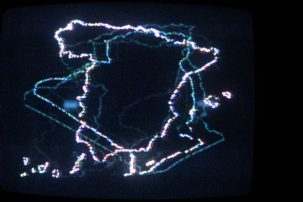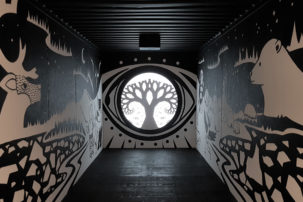Gambletron’s studio is a laboratory: overfull and messy in a way that feels just shy of a breakthrough. They have the exposed circuit boards of toys and small electronics spread out across a few wooden tables and shelves packed with dozens of radios, boom boxes and transistors. Jars and drawers full of small tools and parts are next to rolled-up cords and an array of adhesive tape. Still, these objects and materials only hint at what it’s like to be at a Gambletron performance.
Most bands will play the same song in the same way wherever they perform, but the Montreal artist creates new sounds each time. Gambletron’s mostly improvised performances often invite the audience to join in and are always designed to incorporate aspects of their settings—at an auditorium, in a field, at a metro station, under a bridge. These soundscapes of vocals and field recordings are layered with small synthesizers, circuit-bent electronics and manipulated radio frequencies.
I ask Gambletron’s partner and collaborator Johnny Forever Nawracaj to help describe what it’s like to see them play live. Johnny is a performance artist and scholar who has worked closely with Gambletron since 2013. They tell me about the first time they saw Gambletron perform, at Le Cagibi, a small café. “What I remember most was that cognitive dissonance between the really big sound that Gambletron produces and these tiny, intricate and really precarious objects they use. It was booming dance music intermixed with radio static, and during that performance it was all coming from these different toys that they’d circuit bent—homemade instruments, essentially. One of them was made out of a shitty dollar-store Tupperware container and it had all these switches sticking out of it and wires connecting to it. So the visual mess was coming through audibly in Gambletron’s use of static and technical failure. But the dissonance was between the visual and the sound, because these instruments seemed so small and improbable.”
One of Gambletron’s earliest and most formative experimental performances happened at Sappyfest, a small Sackville, New Brunswick, arts and music festival, in 2009. In a sparsely populated auditorium, where rows of seats descended onto a stage, they played what they say turned out to be one of their most memorable shows. Everything went wrong. There were acoustic and electronic elements that hadn’t been soundchecked. The sound was awful and Gambletron couldn’t hear themself. But they didn’t stop the show or chastise the sound-tech team or walk off the stage. Instead, with awkward charm, they kept trying to find different ways to make it all work. “That was such a disaster,” says Gambletron. “Honestly, that was the worst one. There’s never been a worse moment than that one.”
Gambletron also regularly stages performances with Johnny, who tells me about the role failure plays in their collaborations. “I think that for us, failure is wrapped up with identity and the myth of a naturalized identity, or of a normative social being. And the way we’re presenting ourselves is very imperfect and in-progress,” Johnny explains. “There’s that idea that something well-practised becomes more finely tuned. But I think that actually we’re trying to cut away at that, and, when it comes to identity, understand that through iteration and through doing something over and over again it potentially becomes absurd. It’s not that we’re perfecting this move, it’s that we’re drawing attention to the fact that this move is arbitrary and that we’ve constructed this whole scenario around this one move that in the end has no purpose but to abolish itself.”
During their live performances, Gambletron becomes an aural conductor. They mess with noise or movement or transmission to generate full, textured sounds. Gambletron elaborates on the experience at Sappyfest: “Those were the early days and, as mortifying as that failure was, getting out of failures became an important part of my artistic practice. And as time went on, I became way better at manipulating my failure and then finding myself creating more things to create technical failure to play with…. That aspect of it became part of what I enjoy about being up on stage—how scary and unexpected [it can be] and how I can be nothing but emotionally present when I do these things.” Gambletron calls this failure “technical submission…it’s like canoeing down a rapid. There’s one way you can go, and if you stay on top of where the water pushes up in the middle, you’re going to be fine. And it’s fun—it’s fast and fun.”
With their scrappy, improvised approach to making work, Gambletron has become known as a maverick. More than anything, radio is their primary material.
 Gambletron performing Radio Oscillations at Fonderie Darling in 2013. Photo: Lucas Morin.
Gambletron performing Radio Oscillations at Fonderie Darling in 2013. Photo: Lucas Morin.
Gambletron arrived in Montreal in the early 1990s. At the time, the city was cheap to live in and filled with reckless, creative vitality. The economic uncertainty leading up to the 1995 Quebec independence referendum led many businesses to decamp, and the ensuing recession and high property-vacancy rate left a lot of free space for Anglophone weirdos, punks and art kids from across the country to move in and make Montreal their home. The environment was perfect for experimentation. Unlike many contemporary sound nerds obsessed with acquiring expensive tech, this community created with what they had around them. “The one defining factor of me using objects or finding unconventional ways to make sound was that I was poor,” Gambletron says. “I am generally not a high-income human, so I would just find all these ways to adapt sound with things that I was finding in the garbage.” Around them, their peers—artists and musicians and producers—were opening spaces to host art shows, performances and concerts. “I was part of a queer scene that was part of an indie-rock scene that was part of an art scene that was part of a dance scene…it was so mashed up. We were all in bed with each other.” By the 2000s, Gambletron, who had started out as a singer-songwriter, was playing in indie-rock bands, DJing and doing noise shows at experimental venues.
The sound artist, art historian and curator Esther Bourdages helps me situate their practice: “Gambletron has a bit of indie rock, a bit of punk; they can overlap with experimental music sometimes, and they cross paths with the electronic and feminist and queer [scenes].” In short, Bourdages says, “Gambletron is between a maker and a punk.” Indeed, punk is an attitude, and makers are naturally DIY. With their scrappy, improvised and experimental approach to making work, Gambletron has become known as a maverick. Their practice is part sound sculpture, part performance, part transmission art and part radio art. More than anything, Bourdages says, radio is Gambletron’s primary material. “They have a lot of radios that they craft [and] manipulate, and each one has different sounds, different qualities and different specifications. Gambletron belongs to those artists who will use the wave, the frequency, the radio transmission as a vector of sound by itself.”
If Gambletron had to be situated in a creative landscape, they might land somewhere between Rita McKeough and Throbbing Gristle. McKeough, who started as a musician and then became an artist, makes installations and sound works by circuit bending and manipulating analog and digital technology. Her sound-based installations take up feminist and ecological concerns, but often in playful, surprising, interactive ways. McKeough is perhaps most known for her touring performance installation In bocca al lupo (1991–92), which brought together a choir, dancers and a video projection to evoke a collective voice for women’s anger. Like McKeough’s, Gambletron’s performances are often orchestrated and polyvocal, involving sound sculpture, installation and circuit-bent sound components. While McKeough experiments with robotics in her work, Gambletron almost always uses radio and transmission with handmade circuits for the sole purpose of augmenting and manipulating sound.
At the other end of a spectrum of comparable artists is the late Genesis Breyer P-Orridge, the lead vocalist of the influential English band Throbbing Gristle in the late 1970s, and founder of artist collective COUM Transmissions, a music and performance art collective, which was active from 1969 to 1976. Through music, performance and the very fabric of their life, they were invested in challenging societal norms. Gambletron similarly avoids and defies convention. Their dedication to failure and improvisation is nearly radical in a field that values perfection as success and so often rewards bland, uncomplicated contributions. Like P-Orridge, their work is a mashup of aesthetics and sound. And while Gambletron is mainly influenced by their friends and peers, they recognize the freedom and space created by artists like P-Orridge. “They were like a gateway drug to avant-garde art for me,” they say. “They are an important crossover artist, someone who defies all rules and boundaries not just with gender, but within their music and art practice—[it’s] performance under that one enormous umbrella concept: being Genesis P-Orridge.” P-Orridge’s partnership and collaboration with Lady Jaye was particularly resonant for Gambletron. And one sees commonalities in their iterative performances, which use the body as an instrument and experiment with identity through repetition and failure.
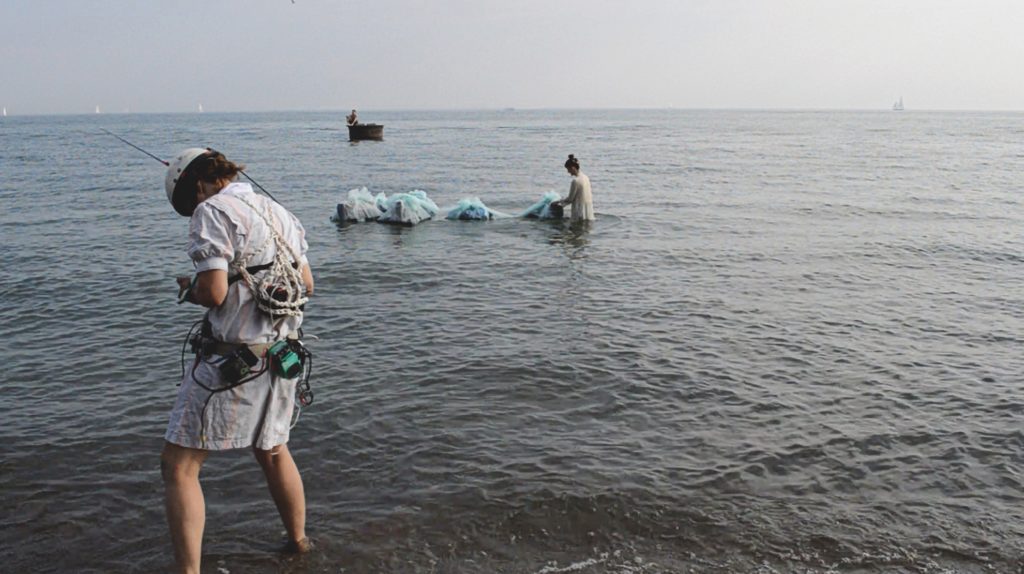
From first: Gambletron and Johnny Forever, Radio Flotilla, performances at Artscape Gibraltar Point in 2015 and La Grande rencontre des arts médiatiques en Gaspésie in 2018. Photos: Mariko Francis/Antoine Amnotte-Dupuis.

From first: Gambletron and Johnny Forever, Radio Flotilla, performances at Artscape Gibraltar Point in 2015 and La Grande rencontre des arts médiatiques en Gaspésie in 2018. Photos: Mariko Francis/Antoine Amnotte-Dupuis.
Largely self-taught, Gambletron developed their practice organically, through curiosity and community, and they have established a reputation for technical skill and unpredictability. In most contexts, this is an incendiary combination. You can find Gambletron’s 2012 sound work Field Trip on YouTube. Audience members were asked to bring a battery-powered radio to a meeting point at Montreal’s Sherbrooke metro station, where Gambletron performed. They velcroed an FM transmitter and a bunch of handmade instruments all over their body and wore a helmet with an antenna and a mic strapped to their face. Their live sounds were amplified by the audience’s radios, which were tuned to the signal of Gambletron’s transmitter. The audience followed them from the subway platform onto a train, and all the way across the city. Field Trip later morphed into the first iteration of Radio Flotilla, in 2015: “For Flotilla, Johnny and I were in drag on a beach on Centre Island and made little rafts for radios, and we floated them out into Lake Ontario. We were encouraging people to get in the water, and Johnny was guiding the radios through the waves. I again had synthesizers on my body, but this time we were playing with the acoustics of the lake.… Water carries sound unlike any other surface, so for me it was about playing with those acoustics. Every time a party boat passed by, the sound, even though it was super far away, would add extra ambience to the general sound that we were creating.”
“Sound is a very easy and very common material, and I feel it’s overlooked,” says Gambletron. As a child, they realized all these ubiquitous sounds could be manipulated to create new, surprising effects. “When my parents were gone, I used to open the piano and put things on the strings—which I now know is called prepared piano—but I was just a kid being a shithead. I would put things on the strings and bang the strings.”
Gambletron became fascinated with the idea of sonic transmission after a friend sent them a video of an experiment in which someone had made a theremin out of three AM radios. The typical theremin is an electronic instrument controlled without physical touch: moving your hand closer or further away from its antennas changes the pitch. Gambletron learned to make their own, and called it their Multi-tonal AM Radio Theremin. “For years my practice was primarily based on working in performance and improvising with the AM Radio Theremin,” they say. “Basically, it was a very unstable instrument. A real theremin is extremely stable and it takes precision to play it. And with this one, no matter how much you tune it or try to play it, the tuning is always going out of whack. The pitch is constantly changing. If there’s wind, the pitch changes. If there’s an electrical disturbance in the air, the pitch changes. If there ever was a Gamble instrument, this was it.”
The largest version of this ongoing theremin project was Gambletron’s creation of Siren: Multi-tonal AM Radio Theremin Drone Oscillator with Transmission, developed at the Wave Farm residency and performed at the third annual “Groundswell” exhibition, which took place at Olana State Historic Site in New York State in 2015. In a grassy field overlooking the Hudson River Valley, dressed in flip-flops and black shorts and again strapped with electronics, Gambletron arranged 21 radios of all sizes—some on the ground, some on small tables, others stacked on top of each other—and then ran between them, tuning each one to push the roaming notes toward harmony, and away from dissonance. Galen Joseph-Hunter, editor of the collection Transmission Arts: Artists and Airwaves (2011) and executive director of Wave Farm, remembers the project: “In their theremin form, the radios are very reactive to the physical environment, to weather patterns, to wind, to what’s happening on the transmission frequency around them. They become almost organic, responsive things, you know, creatures…. So it was a standalone installation, but then you bring a physical audience to it and that responsiveness is heightened even further by [the movement of] physical bodies.”
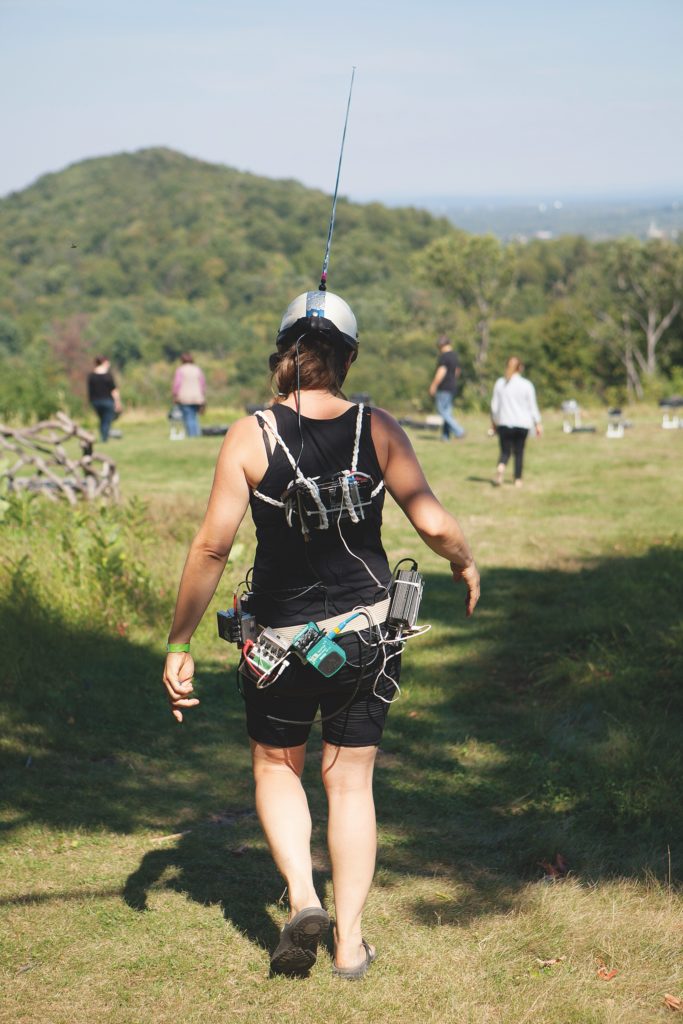 Gambletron performing Siren: Multi-tonal AM Radio Theremin Drone Oscillator with Transmission at Olana State Historic Site, New York, in 2015. Courtesy Wave Farm, Hudson, New York. Photo: Alon Koppel.
Gambletron performing Siren: Multi-tonal AM Radio Theremin Drone Oscillator with Transmission at Olana State Historic Site, New York, in 2015. Courtesy Wave Farm, Hudson, New York. Photo: Alon Koppel.
These days, Johnny and Gambletron have retreated from the pandemic to Vernon, British Columbia, where they are absorbed with a new obsession: transducers. “I started playing with transducers, and I stumbled on this feedback that happens when you put transmission and radio antennas together. Everything leads to another thing, and this led to this dirty feedback that comes from a piece of metal and an antenna and radios and transmitters being fed into places they shouldn’t be. And that shot me into a new direction with transducers, which are objects that can turn any surface into a speaker, essentially. So I’ve been playing a lot with feeding transmission into objects.” Their first project with transducers was Forest Antenna (2018), an interactive sound sculpture they built during a residency at Meinblau, a project space in Berlin. And now, in the small city of Vernon, they’re playing with dirty feedback from radios and transducers and developing new ways to grow and fail.

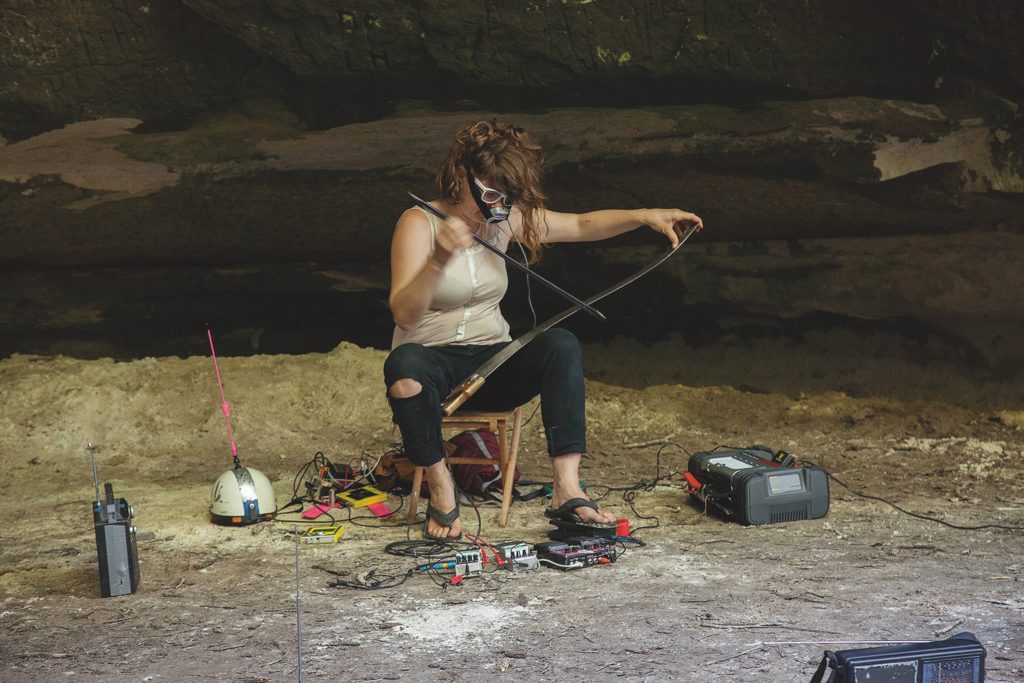 Gambletron performing Ether Underground in 2016. Photo: Meg T. Noe.
Gambletron performing Ether Underground in 2016. Photo: Meg T. Noe.



